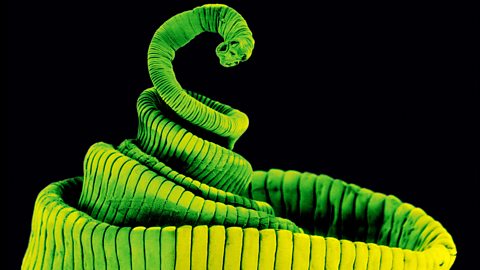Interdependence within a community
Interdependence
Organisms in an ecosystem rely on each other for their survival. This relationship is called interdependenceRefers to the fact that all organisms that live in an ecosystem depend upon each other, for food, protection, shelter, etc, in order to survive.. When organisms interact with one another it affects their survival. This becomes obvious when studying predator-prey cycles, mutualistic relationships and parasitism.
Predator-prey cycles
The graph below shows characteristic repeating patterns called predator-prey cycles.
Predator-prey cycles:
- There are always more prey than predators.
- The number of predators increases because there are more prey, so there is more food for them to eat.
- The number of prey reduces because there are more predators, so more get eaten.
- The number of predators reduces because there is less prey so less food.
There is interdependenceRefers to the fact that all organisms that live in an ecosystem depend upon each other, for food, protection, shelter, etc, in order to survive. between the predator and the prey. Any change in numbers of prey affects the numbers of predators and vice versa. In a healthy, balanced ecosystemThe living organisms in a particular area, together with the non-living components of the environment. the numbers of predatorAn animal that hunts, kills and eats other animals for food. and preyOrganisms that predators kill for food. remain fairly constant.
Mutualism
Some organisms rely on the presence of organisms of a different species. For example, oxpecker birds eat ticks and larvae infesting the skin of buffalo and other large animals. For this reason oxpeckers are called a cleaner species. This is an example of mutualism (new definition) - both species benefit from the arrangement.
Other examples of mutualism:
- Lichens - formed by algae and fungi living together. Algae can photosynthesise and make food, which is shared by the fungus. The fungus in turn shelters the algae from a harsh climate.
- Leguminous plants - peas, beans and clover have colonies of nitrogen-fixing bacteria in nodules attached to their roots. The plants gain nitrogen containing compounds from the bacteria, and the bacteria gain sugars from the plants.
Parasitism
parasiteAn organism that lives in or on another organism (the host). The parasite receives nutrients from the host, harming the host as it does so. are organisms that live on or in a hostThe organism lived on or in by a parasite. organism. The parasite benefits from this arrangement, but the host suffers as a result. Parasites do not usually kill the host because this would cut off their food supply.
Examples:
- Fleas live on the skin of other animals and suck their blood, this feeds the flea but weakens the host.

- Tapeworms live inside other animals, attaching themselves to the host’s gut and absorbing its food. The host loses nutrition, and may develop weight loss, diarrhoea and vomiting.
- Headlice bite other animals in order to feed off their blood.
- Mistletoe roots grow into the veins of the host tree to absorb nutrients and minerals.